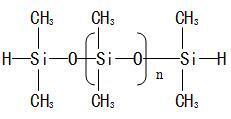End-hydrogen silicone oil is an organosilicon material with a special chemical structure. The following is a detailed introduction to it:
I. Chemical Structure and Characteristics
End-hydrogen silicone oil is a type of silicone oil prepared by reacting tetramethyldisiloxane as a capping agent with octamethylcyclotetrasiloxane (abbreviated as D4). Its molecules contain silicon-hydrogen bonds (Si-H bonds) at both ends, which makes end-hydrogen silicone oil sensitive to acids and bases and endows it with higher chemical reactivity. End-hydrogen silicone oil is a non-toxic, odorless, and transparent liquid, and it is an important key reactive intermediate.
 II. Applications and Fields of Use
II. Applications and Fields of Use
End-hydrogen silicone oil plays a key role in organosilicon chemistry. It is an important raw material for manufacturing various end-group reactive linear modified silicone oils.
As a key intermediate in block copolymerization reactions, end-hydrogen silicone oil plays an important role in the synthesis of organosilicon polymers with special properties.
In the silicone rubber industry, end-hydrogen silicone oil can be used as a chain extender for addition-cure liquid silicone rubber and a cross-linking agent for addition-cure heat-vulcanized silicone rubber, helping to improve the performance of silicone rubber.
In addition, end-hydrogen silicone oil can also be used in modification reactions of plastic resins and other materials to improve their properties.
III. Storage and Precautions
End-hydrogen silicone oil should be protected from rain and sunlight during storage and stored in a ventilated and dry place, avoiding contact with acids and bases. At the same time, due to its active chemical properties, safety precautions need to be taken during use.
In summary, end-hydrogen silicone oil is an organosilicon material with a special chemical structure and wide range of applications. It plays an important role in organosilicon chemistry, the silicone rubber industry, and plastic resin modification.
More details please click
here.
